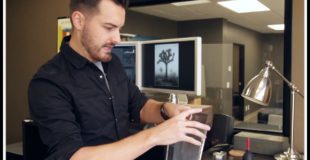With the popularity of social media, many pictures unfortunately never get past a tiny smartphone screen. Digital photo sharing has become the endgame for most photographers. But as a photography teacher, I always encourage my students to create fine art photography prints because the satisfaction that comes from creating your own wall art is unmatched. Having something tangible that can’t be deleted with a single mouse click is what photography’s all about.
So in this video, I’ll show you how I take a medium format film negative from capture, to scan, to print, to framing. Although this print wasn’t made in the traditional darkroom, the quality from my Epson V750 scanner coupled with professional grade printing techniques resulted in a superb print worthy of framing.
This first of two videos in “Making a Fine Art Photography Print” shows my unique scanning process and how to prep the file for print using Adobe Photoshop Lightroom. In the next video, we’ll look at the how to deckle the edge of watercolor paper to create an awesome “raw” look to your fine art.
The photography print I made in this video is from a scanned 6×7 negative shot with a Mamiya RZ67 camera in Joshua Tree National Park. The film used was Ilford Delta Professional 100 medium format film. The scanner used is an Epson V750 with SilverFast software. I used watercolor paper and had it float-mounted in a shadowbox frame.
View “Making a Fine Art Photography Print (2 of 2)”: http://youtu.be/ijabXZ3O-lI
View the on-location video where I took this photo: https://www.youtube.com/watch?v=3RanBtwmSoQ
Ground glass by Hopf Glass: http://www.hopfglass.com/
Printing by Pro Photo Connection in Irvine, CA: http://stores.prophotoirvine.com
Framing by Salamon Art in Fountain Valley, CA: http://www.salamonart.com
Nick Carver Photography Main: http://www.nickcarverphotography.com/
Online Photography Courses: http://www.nickcarverphotography.com/teaching/online_courses/
Orange County Photography Classes: http://www.nickcarverphotography.com/teaching/classes/
Original source

31 responses to “Making a Fine Art Photography Print (1 of 2)”
I am newbie to this analogic stuff. Why scan on tiff? Wouldn't RAW be more suitable?
Great channel, videos and photographs!
Congratulations from Brazil.
Hi NICK, Whats the thickness of the shims and what material are they made of?
Fine art photography?
Also, how does one know if his monitor levels are correct … too dark too light. I find that I need to brighten the final a bit to avoid blocking of blacks.
I always reasoned that remove the dust spots on the scan first, then fix contrast and brightness levels. In your opinion does it matter what sequence is used? or did I miss something here? Love that fog btw.
Question… I love the large format film, but… Since you are scanning your negatives, why wouldn’t you just go entirely digital? Your work is awesome, and understated is the best art for walls you can get 🙂
Do you scan negatives emulsion side to the glass or emulsion side to the scanner?
home scanning film negs sucks dicks cause you have to post process to correct
Hi Nick, Where do you purchase your metal file folder boxes and seen at the beginning of this video? Keep up the great work!
Great video Nick, btw, what make is that desk lamp
That's a very interesting method of scanning negatives! I'm going to have to try that vs. the regular method on my Epson V800. For 35mm, I use a Nikon CoolScan V.
i realy dont get why one would scan a film negative to make a print.
Hey Nick, where did you get the 3mm white shims by the way?
yeah, always getting newton rings on my 4×5's, will try your set up….thanks for the video, always nice to pick up on the techniques of others.
Hey Nick, been enjoying your videos. What company/kind of archival binder is that? And what archival storage sheets are those?
Nick, can I ask the specs on the shim height or what you're used as shims? Thanks.
Man I wish you'd stop hating on digital and inkjet. It really ruins your videos.
Would you consider getting a Flextight?
What size was it printed? Nice videos, cheers!
One professional photographer said that lightroom's sharpening is bad and he adviced to always zero it and to sharpen images in photoshop with high pass. Any idea why he said that? 😮
can you not tape the film to the actual scanner glass ?
Why not get a second pane of glass and lay it on top of the negative? This would negate the need for tape.
Hi. i want to know the thickness of two white stick that you use.
You comment that your process adds a little grain to your scans, is there a way to not add grain to the scan? Perhaps a different glass/mount?
nice video
You're work is classic and timeless. Very much how I would love my work to end up hanging on a wall. Thanks for sharing you're knowledge. These videos are invaluable.
Excellent videos, what do you think about the v750?
make more vids man ur work is awesome
You should also try a hybrid form of printing. You take a digital photograph and print it on B&W silver gelatin paper. The blacks & dmax will blow your mind away, believe me. Thank you for these very inspirational video series.
Aw man new video finally! Welcome back Nick!
Hey Nick, can you explain why you prefer light jet over inkjet printing? I've always been very pleased with high quality pigment inkjet prints; and other than the differences in the aesthetics between the two, have never really been unhappy with the quality of either.